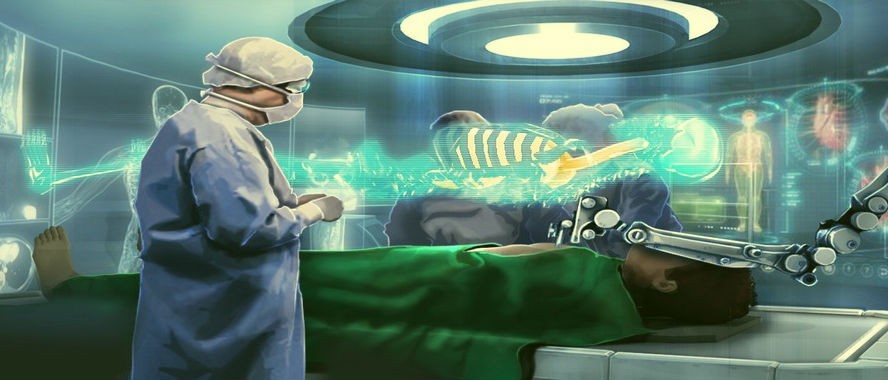
- Date: Sep 19, 2019
- Category:
- What is Augmented Reality?
- How Can Augmented Reality Help Both Patients and Healthcare Professionals?
- What Opportunities Augmented Reality Offers in Healthcare?
- How AR Benefits in Medical Training and Education?
- Which Companies are Providing AR Training and Education Solutions to Healthcare Professionals and Students?
The application of Augmented Reality (AR) is eventually gaining momentum. With various industries embracing this latest technological innovation, the healthcare industry is nowhere behind when it comes to adoption and implementation of AR. From surgery to diagnosis, the positive impact of AR in enhancing the abilities of healthcare operations is quite noticeable. That is why the global market for augmented reality is expected to reach $1.5B by 2020, which is indicative of its growing popularity.
In the healthcare space, AR has helped surgeons and doctors with access to real-time data that have made a surgical intervention, diagnosis, and patient treatment more advanced and efficient. Even in the medical training and education field, AR’s contribution is unavoidable. The technology of augmented reality has added value to practicing medicine by enabling students to visualize health scenarios and practice on 3D models so that they are well-trained to deal with particular medical conditions even before they try their expertise on real humans. AR has brought a transformative change in the healthcare sector. However, at present, the AR technology remains partially explored, and lots more innovation can be expected in the days to come in the field of medicine and patient care in particular.
What is Augmented Reality?
Augmented Reality (AR) is an evolving technology that creates a real-world environment by displaying digital media and information in real-time. The real-word interactive experience that AR creates is projected via videos, 3D models using the camera of your PC, mobile, tablet, and even wearable tech. It works on computer vision which is based on several algorithms that augment graphics, sound, and other sensor-based inputs. AR renders real-life information and displays it in an interactive way, making virtual elements a part of your real-world.
How Can Augmented Reality Help Both Patients and Healthcare Professionals?
For Patients:
- AR application can improve the quality of care from healthcare providers.
- Brings in more precision and accuracy during surgery, reducing risks.
- Makes surgical procedures minimally invasive.
- Saves patient life during an emergency by providing quick information to paramedics.
- AR apps can educate family with regards to the health conditions of the patient.
- Reduce pain and discomfort during blood tests, helping nurses locate the right vein.
- Help patients keep track of medicine and other aftercare routines with AR apps.
- Possibilities of human error reduces with better management of patient records.
For Doctors:
- AR technology supports in medical training and education of students.
- Allows trainee physicians to visualize health issues during training better.
- Provides access to real-time patient data which helps doctors in seamless diagnosis and treatment.
- Surgeons no longer need to require to have large displays in the operating room for vital stats.
- AR helps the surgeon to stay focused, minimize mistakes and do multitasking without difficulty.
- Provide doctors with patient information in seconds to deal with emergency cases.
- Surgeons can perform more accurate and low-risk surgeries using AR.
What Opportunities Augmented Reality Offers in Healthcare?
To a greater extent, AR is closely related to VR. While virtual reality entirely replaces user’s real-life environment with a stimulated one, AR is more into altering the ongoing perception of the user about a real-world setting. In the healthcare field, there are multiple possible applications of AR which is intended to make health care facilities way more efficient than they are in the present. Here are some areas where augmented reality has been making its presence felt with the purpose to trigger innovation and ensure better patient care:
Augmented Surgery
- Before actually performing surgery, AR allows surgeons to visualize muscles, bones, and other internal organs of the patient without even cutting open a body.
- Surgeons can precisely study patient anatomy just by entering CT scans and MRI data into their AR headsets to get an overlay view of vital organs in an enlarged 3D version.
- AR enables less invasive surgical procedures by providing all the necessary visuals surgeons may need to start their analysis.
Augmented Diagnosis and Treatment
Application AR in patient diagnosis and treatment helps in the following ways:
- AR helps in better diagnosis and determination of patient’s health symptoms.
- AR enables healthcare professionals to monitor and identify issues in patients faster.
- Augmented reality apps allow doctors to compare results and document noticeable changes over a particular period to offer the right treatment.
- Nurses, physicians, and technicians get hold of accurate visual data and real-time information for error-free diagnosis.
How AR Benefits in Medical Training and Education?
Considering the potential and the many benefits of AR application in the healthcare industry, medical institutions are slowly taking an interest in implementing AR into their curriculum. It is helping students with practical knowledge and hands-on experiences which is proving beneficial for their medical education and training.
- AR in medical training and education has the following advantages:
- Stimulating surgical and patient encounters for students to learn and make mistakes by practicing on AR rather than on real patients.
- Students are learning to diagnose patients through AR supported diagnosis or surgical procedure accurately.
- AR is also allowing medical professionals to observe students during their AR practice and give valuable feedback for further improvement.
- With AR implementation, medical education is more systematic and organized.
- Students can practice everything in a real-life medical situation created by AR and not in some random dissection labs.
- AR will enable medical students to visualize and practice theories which were earlier limited to texts only.
- Medical trainees can use AR apps to overlay patient anatomy on a 3D human skeleton to better understand the various aspects and functioning of human body.
Which Companies are Providing AR Training and Education Solutions to Healthcare Professionals and Students?
ImmersiveTouch:
As a leader in the medical simulation technology space, ImmersiveTouch offers Virtual Reality (VR) and Augmented Reality (AR) education and training solutions. The company’s technology backed medical education solution includes cutting-edge surgical simulators and learning management systems. ImmersiveTouch’s VR platform enables surgeons to simulate, rehearse, and plan complex surgeries using patient data. The company’s innovative technology-driven medical training and education systems and platforms are used across various medical centers, including the University of Calgary, the University of Chicago, and more.
Touch Surgery:
The Touch Surgery mobile app provides users a mobile surgical training platform that stimulates surgical procedures so that users can practice surgery any time at any place. The app has an interactive surgical simulator that provides step-by-step guidance throughout every stage of the operation. With the help of its sophisticated technology leverages in Touch Surgery app, the healthcare technology company Digital Surgery LTD, is trying to improve the quality of surgical procedures. This app is also helping medical students, trainees, and healthcare professionals in their education.




